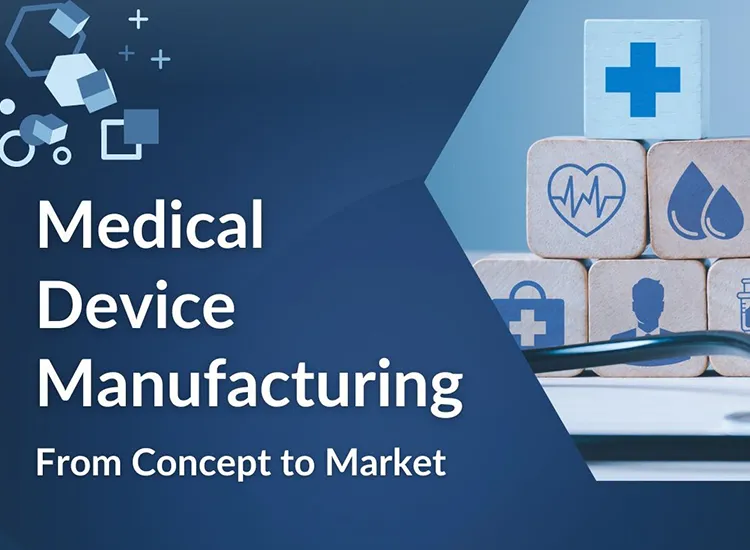Medical Device Manufacturing: From Concept to Market

Medical devices play a crucial role in modern healthcare, aiding in diagnosis, treatment, and monitoring of patients. Their development and manufacturing are highly regulated, demanding strict adherence to quality control measures, certification processes, and clean room environments to ensure patient safety, efficacy, and advance healthcare globally.
Evolution of Medical Device Manufacturing
The genesis of medical device manufacturing dates back centuries, evolving from rudimentary instruments to sophisticated, high-tech devices. Historically, medical instruments were crafted by hand with limited precision and consistency. However, technological advancements in the 20th and 21st centuries revolutionised this sector.
Quality Control: Ensuring Safety and Reliability
Medical devices are held to the highest quality and safety standards, as they directly impact human health. A comprehensive quality control system is essential throughout the development and manufacturing processes, encompassing various stages such as:
- Design phase: Rigorous testing and evaluation of prototypes to identify and eliminate potential defects. Engineers collaborate with healthcare professionals to conceptualise devices that address specific medical needs. Computer-aided design (CAD) and simulations allow for precise modelling and testing before creating physical prototypes.
- Materials Selection: Choosing appropriate materials is critical in medical device manufacturing. Biocompatibility, durability, sterilisation compatibility, and regulatory compliance are essential considerations. Metals, polymers, ceramics, and composite materials are carefully selected based on the device’s intended use.
- Manufacturing Techniques: Medical device manufacturing employs various techniques such as additive manufacturing (3D printing), CNC machining, injection moulding, and laser cutting. These methods ensure precision, scalability, and repeatability in production.
- Production phase: Ongoing monitoring of raw materials, manufacturing processes, and finished products to ensure compliance with specifications.
- Testing phase: Exhaustive testing of devices to verify performance, safety, and efficacy.
- Post-market surveillance: Continuously monitoring device performance in real-world settings to identify and address any issues that may arise.
Certification: Gaining Regulatory Approval
Medical devices must undergo a stringent certification process to gain regulatory approval before being marketed. The specific requirements vary depending on the device’s classification and intended use. Common regulatory bodies include:
- CE (Conformité Européenne) marking in the European Union
- PMDA (Pharmaceuticals and Medical Devices Agency) in Japan
- Health Canada
- FDA (Food and Drug Administration) in the United States
The certification process typically involves submitting detailed documentation, conducting clinical trials, and undergoing inspections to demonstrate compliance with regulatory standards.
Clean Rooms: Maintaining Sterility and Preventing Contamination
Medical devices must be maintained in a clean environment to prevent contamination and ensure patient safety. Clean rooms play a critical role in achieving this level of sterility. These specialised environments have controlled airflow, temperature, and humidity to minimise the presence of airborne particles.
Clean rooms are classified according to the level of cleanliness required. Class 1 clean rooms, the most stringent, are used for manufacturing implantable devices and other sensitive medical products. Any reputable medical device manufacturing facility should have varying levels of clean rooms and provide you with a tour.
Challenges and Innovations
- Regulatory Compliance: Navigating the complex web of regulatory requirements across different regions poses a significant challenge for manufacturers. Keeping abreast of evolving standards demands continuous adaptation and expertise.
- Cost Control: Balancing innovation with cost efficiency is a perpetual challenge. Manufacturers strive to develop high-quality, innovative devices while managing production expenses and ensuring affordability for healthcare providers and patients.
- Technological Advancements: Continuous technological advancements, such as integrating IoT (Internet of Things) in medical devices for data collection and analysis, drive innovation. Robotics, artificial intelligence, and nanotechnology are revolutionising device capabilities.
Medical Device Manufacturing Impact on Healthcare
Medical device manufacturing has substantially influenced healthcare delivery and patient outcomes. Innovations like pacemakers, prosthetics, imaging devices, and minimally invasive surgical tools have enhanced diagnosis, treatment, and patient care.
Future Trends
Advancements in genomics and biotechnology are paving the way for personalised medical devices tailored to an individual’s genetic makeup, improving treatment efficacy and patient outcomes.
Sustainability
The industry is increasingly focused on eco-friendly materials and manufacturing processes to reduce environmental impact.
The Culmination of Rigorous Standards: A Device Ready to Market
Medical device manufacturing stands as a cornerstone of modern healthcare, seamlessly blending technological innovation with precision engineering and stringent quality control. As the industry continues to evolve, its impact on healthcare, from improving diagnostics to enhancing treatment options, remains pivotal in shaping the future of medicine.
The journey from concept to market is a testament to the dedication of medical device manufacturers to ensuring patient safety and efficacy. Their commitment to rigorous standards is essential for delivering innovative and life-saving technologies that improve healthcare outcomes worldwide.
Pivot International has over 50 years of bringing medical devices to market. We started in the fitness industry, designing and manufacturing motors and health monitors for treadmills. Today we have evolved into developing award-winning devices that use AI technology. To find out more how we can help bring your medical device to market, contact our team.

